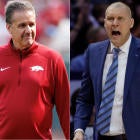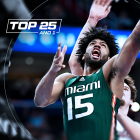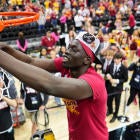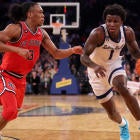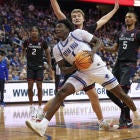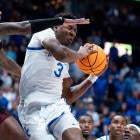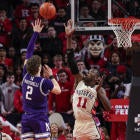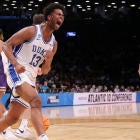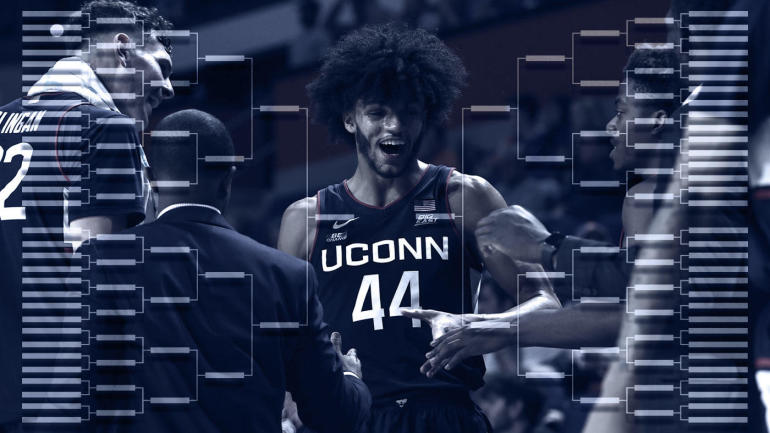
The first regular season Bracketology projection is out and we have already had massive turnover at the top of the bracket from the preseason. In fact, we were a Virginia win over Houston away from something I have never done before. This could have been the first time in 30 years of doing bracket projections that none of the teams that were No. 1 seeds in the preseason bracket were still on the top line in the first bracket update. However, the Cougars won, so they are the lone team among the preseason top seeds that is still a No. 1 seed.
The overall No. 1 seed is not an easy call.
Purdue has gotten off to a great start with dominant wins over Duke and Gonzaga in the Phil Knight Legacy last month. However, the Boilermakers struggled to win their last two games, an overtime win at Nebraska and an eight-point win over Davidson in Indianapolis. Despite having the early leader for national player of the year in Zach Edey, Purdue's offense is unstoppable only if the Boilers are hitting their 3-pointers. In the games in which Purdue has shot 33% or better from beyond the arc, they have averaged 82.3 ppg. That number falls to 68.0 ppg when the 3-point percentage is less than that, which is what happened in the Boilers' last two games.
UConn is also off to a tremendous start. Like Purdue, the Huskies were unranked to start the season, but they have steamrolled their opposition so far and risen to No. 2 in the polls. Also like Purdue last season, they are splitting time between two centers – 6-foot-9 junior Adama Sanogo and 7-2 freshman Donovan Clingan. They are a better defensive team than last season's Boilermakers and that is a big reason why the Huskies have laid waste to their opponents so far this season. They have a 15-point win over Alabama and a 21-point victory at Florida that was not as close as the score would indicate. All twelve of their wins have come by double digits.
Because of the more dominant performance by UConn against its schedule, I have the Huskies as the overall No.1, with Purdue at No. 2.
Reigning champion Kansas is the No. 3 overall seed. The Jayhawks have wins over Duke and Wisconsin, along with a blowout of Indiana on Saturday. Their only loss came to Tennessee in the championship game of the Battle 4 Atlantis. The Jayhawks are being led by junior Jalen Wilson who leads the team in scoring and rebounding at 21.1 ppg and 9.3 rpg. Freshman Gradey Dick is off to a tremendous start as well, averaging 15.8 ppg.
Houston is the fourth No. 1 seed after the Cougars' win at previously undefeated Virginia on Saturday. The Cougars struggled with Kent State and St. Mary's before finally losing at home to Alabama. The win over the Cavaliers is huge for Houston as this season goes on because unlike the other teams on the top line of this bracket, the Cougars will not be able to resume build in conference play as much as teams usually can in the American Athletic Conference. The only other team in the AAC that looks like a likely NCAA Tournament team right now is Memphis..
Bracketology top seeds
Check out Palm's latest bracket, full field of 68 and all the teams on the bubble on the Bracketology hub.
What happened to the other No. 1 seeds from the preseason bracket?
Gonzaga – The Zags have still had a great season so far, including a win over Alabama in Birmingham over the weekend. They are still a No. 3 seed and barring an upset in conference play, will likely move up from there.
North Carolina – The preseason No. 1 team in the polls struggled against better competition early on, losing to the four best teams that had played prior to defeating Ohio State on Saturday. The Tar Heels returned a lot from last year's team, but things haven't jelled as well as coach Hubert Davis would like. Maybe Saturday's overtime win over the Buckeyes in the CBS Sports Classic will be the catalyst to playing better going forward. The Tar Heels are currently a No. 7 seed.
Kentucky – The Wildcats returned last year's Naismith National Player of the Year Oscar Tshiebwe, but the team has not come together around him yet. They have had problems with the better teams they face. Gonzaga routed the Wildcats and UCLA had their way with them as well. The Michigan State loss really stings because the Spartans rallied to send it to OT, where they eventually won. Kentucky is also a No. 7 seed in this bracket, but I believe there is more reason for optimism with UNC than with the Wildcats at the moment.
Picking the best of the rest
The hardest thing about mid-December brackets is that because there are hardly any conference games played so far, I find myself trying to choose between teams with gaudy records and crappy schedules or teams with crappy records that overscheduled. Do I choose Oregon, with a killer schedule it wasn't up to and which has Nevada for its best win or perhaps Kansas State, with its lousy schedule and also with Nevada as its best win? Ideally, neither – but I have both in the bracket. This is why we only do one December bracket.
Another weird thing about this particular bracket is that Ole Miss will have played Oklahoma and Oklahoma State and all three are in the First Four. There is no way to bracket those teams without having a regular-season rematch. When it comes to the First Four, typical bracketing rules get set aside for reasons like this.
Numbers not reliable yet
Also, at this time of year, there are not enough games played for any computer rankings to be reliable. About 1/3 of Division I teams have yet to play ten games against D-I opposition and no team has played more than 13. It is easy to look through the NET ratings and find several anomalies.
Also, ranking systems like KenPom.com and Jeff Sagarin's ratings, for example, mitigate this by including data from previous seasons to fill in the blanks, so to speak. As the current season goes on, the amount of data from previous seasons decreases and eventually goes away entirely. However, for now and for about another month, these rankings are not judging teams strictly by what they have done this season.
So, at this time of year, judging anything by the computer rankings is folly. The quadrants are not useful because of the many outliers in the NET.
Furthermore, at no time does the NCAA Tournament selection committee make decisions based on rankings alone or even primarily. They are not even a tiebreaker. If all you have is good computer rankings, you have nothing. If the details of a team's resume do not match the rankings, it is the details that matter, not the rankings. Because a team's schedule is divided into quadrants on team sheets, the NET rankings of a team's opponents are more important than its own ranking.
So, when you try to make a case to me for your team or against another in the bracket, leave out the computer rankings. Besides, I already know them.
As for this bracket, I did not use the rankings at all with one exception. To determine each conference's automatic qualifier in the bracket, I use the team with the fewest conference losses and use the NET as a tiebreaker. This helps me automate that process and I will do that for most of the rest of the season. Once a conference's tournament seeding is determined, the top seed remaining in that tournament is the AQ in the bracket.






















